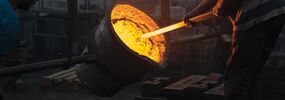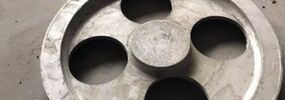Casting Sector Sektörü Ürün Grupları
5 Category




Konya Casting Industry
As Turkey's casting industry, it is the 9th largest producer in the world and 2nd in Europe. Konya is one of our most important provinces in this great success. There are companies operating at world standards in Konya Casting sector.
Casting industry is perhaps one of the most important sectors when working. There are several safety hazards in the foundry industry. Some of these are common to all foundries, but others are specific to certain processes. For example, flash hazards can occur during magnesium casting. The following list highlights the most common foundry safety hazards and provides guidelines for avoiding them.
High levels of noise and vibration are common in foundries. These can cause hand-arm vibration syndrome, causing injuries and can also affect the eyes. Some foundries also have low standards of cleanliness and lots of travel hazards. Workers can also experience stress and anxiety when working in these environments. In addition, exposure to ultraviolet light is risky.
Smoke is another common occupational hazard in foundries. The metal smelting process creates a significant amount of smoke, and the smoke particles are extremely fine. These particles contain high amounts of SiO2 and Fe. The most common metal furnaces used in foundries are cupola furnaces that produce the most smoke. Other hazards include dust from silica sand and olivine sand. Inhalation of these particles can cause lung diseases. Long-term exposure can also lead to lung cancer.
Besides dust, foundry workers are also exposed to a number of other harmful substances. Fine respirable dust from the foundry process can cause lung damage, while metal dust from ferrous foundries can be hazardous to the respiratory system. Some sand stabilizers contain acids and phenol. They can also be contaminated with chlorine and aluminum.
Noise pollution is another occupational hazard that can adversely affect health. It affects employees by affecting their ability to sleep and relax. It can also affect nearby residents. It is important to ensure that foundry workers use soundproofing gutters to reduce noise levels. Soundproofing gutters can be installed using sputtered sound absorbers or aluminum cladding.
Metal casting is an intensive process that can cause serious injury. This process involves pouring the liquid metal into a mold that is usually shaped as a cavity within a sphere. After pouring, the mold passes through the cooling and shaking tunnel. Smaller foundries, however, can pour directly onto the foundry floor. This type of operation still involves risks such as exposure to dust.
Exposure to silica dust in the foundry
There are many different ways that workers can be exposed to silica dust. One of the best ways to determine silica exposure is to look at the dust residue left behind by a process. Other conditions may be less obvious but still result in unsafe exposure. Some of the more common scenarios include sand casting processes, permanent molding and centrifugal casting processes.
Exposure to respirable crystalline silica should be monitored and controlled. It is essential that employers monitor workers' exposure levels and take appropriate protective measures. Monitoring is often done through exposure mapping and real-time tools that help identify sources and identify appropriate cleanup methods. In addition, employers should always use disposable clothing when working in areas with high levels of silica dust.
While the proposed arrangement is beneficial for workers, many foundry managers worry it could wipe out the industry. Proposed regulations will require foundries to invest in additional dust collection systems and increase air quality testing. However, it will do little to prevent silica exposure. It will also increase costs for businesses.
Exposure to silica dust is a serious health risk for foundry workers. It can be dangerous and is responsible for many serious diseases. The best way to prevent silicosis is to limit worker exposure to silica dust. It is important to ensure that workplaces use industrial hygiene programs to monitor worker exposure levels. The hazards that may occur in foundries all over the world are approximately as we have stated above. Konya casting companies have aimed to reduce the accident rate as much as they can by taking the highest possible precautions.
Products Produced by Konya Casting Firms
Metal casting requires the highest level of attention and control throughout the production process. To ensure consistent quality, a foundry must implement a quality management system and have the resources and capability to support it. Quality assurance is essential because failure to implement quality measures can lead to downtime and a defective product. In order to ensure that the quality of your product and the safety of your employees are at the highest level, you can ask about the quality control practices at every stage of design and production by contacting Konya casting companies.
One of the most important hazards in foundry work is the high temperature of metals. Temperatures in foundries can reach up to 2600 degrees Fahrenheit. These temperatures can cause unpredictable chemical reactions. Steam explosions may occur if the process is not properly followed. To minimize the risks associated with these conditions, only experienced foundry workers should work in foundries.
The global market for products manufactured in foundries can be divided into four geographic regions: North America, Latin America, Asia Pacific, Europe and the Middle East and Africa. The Asia-Pacific region is the fastest growing region due to industrial growth, urbanization and investments in the automotive industry. In this region, China is the largest metal casting producer. Europe follows Asia Pacific closely due to its large automotive industry base.
The casting products market is driven by increasing demand for infrastructure, power generation and the automotive industry. Other factors driving the market include rapid industrialization and technological innovations. Despite these factors, there are some significant challenges hindering the growth of this industry. To meet these challenges, foundries need to ensure that their employees are protected by implementing the most effective security measures.
The final shape of a cast product is determined by its mold. The mold can be made of wood or metal or a replica of an object. The materials used to make the mold depend on the metal to be cast and the type of casting method used.
Chemical Market in Konya Casting Sector
Automotive industry is an important application for foundry chemicals, especially aluminum, which is light and fuel efficient. In addition, foundry chemicals can be used to manufacture complex metal parts. Advanced technological developments are also affecting the foundry chemicals market. Many foundries are now integrating 3D printing to produce complex parts. However, stringent environmental regulations are expected to limit market growth.
The global foundry chemicals market is dominated by Asia-Pacific, with China leading the way. The region is expected to grow at the fastest rate during the forecast period. High growth in this region is primarily attributed to high steel and automobile manufacturing in China. North America and Europe are also important markets with large metal-based product production.
The Global Casting Chemicals Market Report provides the latest industry data, including market size and growth, competitive landscape, and key regional and country-level data. The report also analyzes industry structure and trends and forecasts future market growth. It includes regional and country-level market data for each segment. You can also learn how the industry is structured and who are the leading players in each region.
In 2021, the Asia-Pacific region had the largest share of the global foundry chemicals market in terms of both value and volume. The region is expected to continue to be highly profitable during the forecast period. Rapid industrialization in Asia-Pacific countries will increase the demand for casting products in the automotive and aerospace industries.